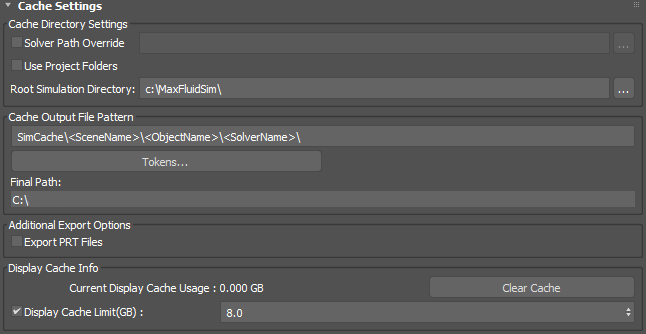The user cache stores the computed fluid simulation as files on disk pers frame. The simulation then reads the cache files for each frame, instead of recomputing the simulation. The Caching panel allows you to configure the parameters.
Cache Settings rollout

Cache Directory Settings group
- Solver Path Override
- Overrides the file path for storing simulation cache files per solve and allows direct pathing. This setting disregards the token system.
- Use Project Folders
- Sets the project folder as the root directory for simulations.
Tip: If multiple people are working with/on the simulation, you can set the path so everyone has access.
- Root Simulation Directory
- Specifies a directory for storing the root simulation.
Cache Output File Pattern group
- File Pattern field
- Defines a pattern for naming the output cache files using a series of tokens.
- Tokens...
- Displays a list of supported tokens to add to the end of Cache Output File Pattern field. The supported tokens are:
- Project Name
- Object Name
- Solver Name
- Frame Range
- Scene Name
- Frame Rate
Click anywhere in the pattern string and then select a token to add it there. You can right-click the field to access options such as Cut, Copy, and Paste, as well as Undo and Redo.
- Final Path
- Displays the final path resulting from the selected tokens.
Additional Export Options group
- Export PRT Files
- Exports PRT files containing 3D modeling information and channel data in a global format. When this option is enabled, simulating liquid and foam components will generate PRT files and place them under the same cache output path in folders named Liquid_PRT and Foam_PRT.
By default, the PRT files contain Position, Velocity, Density and Vorticity channel information. There are editable .ini file options for PRT export, which are listed in the 3dsmax.ini under [Fluids].
The file options are:
- PRTFileVersion=1 (.prt version 1 files)
- PRTFileVersion=2 (.prt version 1.1 files) (Default)
- Sets the export of the Density channel. Default is 1 (yes):
- PRTDensity=0
- PRTDensity=1
- The following switches determine whether to export individual channels from the fluid simulation to the PRT file (1=yes,
0=no):
- PRTPosition
- PRTDensity
- PRTVelocity
- PRTVorticity
- PRTID
- PRTAge
- PRTAirDistance
- PRTChurn
- PRTCurvature
- PRTDroplet
- PRTExpansionRate
- PRTStictionStrength
- PRTStictionBandwidth
- PRTUV
- The following switches specify user-defined overrides for the fluid channel names. Some third-party software expects certain names for channels stored in .PRT files; these options let you specify the name for a given channel (for example,
PRTVelocityName=Speed):
- PRTPositionName
- PRTDensityName
- PRTVelocityName
- PRTVorticityName
- PRTIDName
- PRTAgeName
- PRTAirDistanceName
- PRTChurnName
- PRTCurvatureName
- PRTDropletName
- PRTExpansionRateName
- PRTStictionStrengthName
- PRTStictionBandwidthName
- PRTUVName
- Specifies the data format for the fluid particle ID value:
- PRTIDFormat=xxx
Allowable values for xxx: 32 (32-bit unsigned), 64 (64-bit unsigned), 32S (32-bit signed) and 64S (64-bit signed)
- Specifies the data format for the fluid particle UV data:
- PRTUVFormat=x
Allowable values for x: 2 (two component (UV)) or 3 (three component (UVW))
-
Sets the option for the soft-lock timeslider feature during simulations:
- SoftTimeLock=0 (off)
- SoftTimeLock=1 (on)
- Sets the option for the 'Disable soft-lock on Time Change' feature:
- SoftTimeLockChangeDisable=0 (off)
- SoftTimeLockChangeDisable=1 (on)
Display Cache Info group
- Current Display Cache Usage
- Shows the current cache usage for displaying the simulation.
- Clear Cache
- Clears the viewport cache from memory.
- Display Cache Limit (GB)
- When enabled, sets the amount of memory allocated to viewport caching of the simulation. When disabled, only one frame is cached at a time. Changing the Display Cache Limit settings can be particularly useful when working with heavy simulations requiring large amounts of memory.
